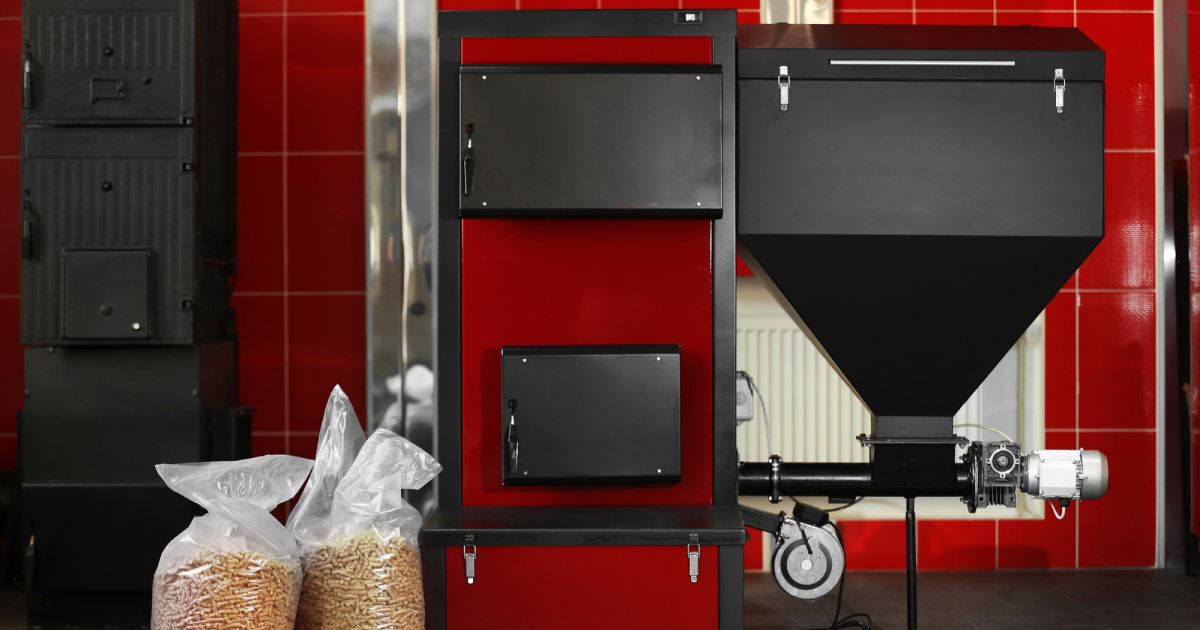Yes, you can install a pellet stove in the basement. In fact, your basement can be the ideal location for your new pellet stove. However, to safely install a pellet stove, there are a few things you need to do. This includes adequate venting, ensuring plenty of clearance, and reviewing local building codes.
This guide explains how to safely install a pellet stove in your basement in this article, so continue reading to learn more!
Will A Pellet Stove In The Basement Heat The House?
While you could position your pellet stove on an upper level of your home, a basement installation can be the perfect spot. In most cases, the basement is one of the coldest areas of the house, so positioning the stove here is sensible.
On top of that, hot air rises, so the pellet stove’s heat will naturally rise into the upper levels of your home.
With an efficient ventilation system, a pellet stove located in the basement can help heat your home, even the upper levels. If you want the heat to spread faster, you can position fans to blow the air up the stairs. And you can turn on ceiling fans upstairs to further circulate the warmth.
Note: Without an adequate ventilation system, it might take longer for the stove to create a noticeable difference throughout the entire house.
As a cherry on top, pellet stoves utilize convection heating. This means pellet stoves use convection blower fans, unlike wood or coal stoves. The fans help circulate warm air, ensuring it moves throughout the space. While radiant heat will do the trick, these convection blower fans help heat the area more evenly. And unlike wood stoves, pellet stoves produce much less pollution.
Pellet Stove Installation In A Basement
Installing a pellet stove in your basement can be a great way to heat your house, especially if you have a larger home. Heating costs with gas and electric heating systems can quickly become astronomical, so pellets as a heating source are a solid alternative.
While basement installations are a good option, you will still need to plot out where to place the pellet stove. It needs access to an electrical outlet to supply power, which is how it cycles wood pellets from the hopper into the firebox. In addition, the stove will need to be vented, so you’ll want it reasonably close to an exterior wall.
What Safety Measures Should You Consider At Installation?
As with nearly any heat source, safety is imperative. So, before you install your pellet stove, you need to plan out the details. In addition to the above mentioned considerations, you’ll need to consider spacing. The stove needs plenty of clearance, as the heat could cause things around it to catch fire. So, you’ll need to position it in a fire-safe spot with plenty of room around it.
In addition, you need to plot out a vent for the system. Although pellet stoves burn much cleaner than alternative heating sources, like coal and even propane home heaters, they still need ventilation. Since carbon monoxide poisoning is still risky with this heat source, you must determine a good place to position the vent.
Every pellet stove model is different, so be sure to read through the installation instructions that come with your stove. In many cases, the manufacturer will outline specific installation advice, so be sure to take note of these factors. For example, it will likely outline exactly how much clearance the vent needs from windows and doors to prevent carbon monoxide from re-entering your home.
Last but not least, check with your local building authority.
Note: Some areas outline specific requirements for these installations, so ensure you verify your installation is up to code.
Internal Wall Installation
An internal wall installation is one option for installing your pellet stove. With this option, you’ll mount the pellet burner against an interior wall. The flue will extend straight up through the roof, mimicking the venting system standard with wood-burning stoves.
If you decide to use this installation method, you’ll need to fit the system with an adapter and route the vent system to the roof. On top of that, the system needs to include a ceiling holding box, a leaking kit, and an overhead insulation cover.
Unfortunately, you’ll need to cut holes throughout your home with this method, including the basement, upper floor, and roof ceilings. This makes the internal wall installation more complicated and expensive. But as the warm exhaust travels through the vent inside your walls, it will heat your home a bit more.
External Wall Installation
Another option for your pellet stove is an external wall installation. In this method, you’ll mount the pellet stove alongside an exterior wall of your home. The flue will extend horizontally through an outer wall, running straight from your wall to the outdoors.
Given the design of this installation option, you’ll need to use an L-vent pipe. This option is relatively simple, as you only need to cut a hole in the side of your home. However, this option might not be suitable for every scenario, as the pipe needs to rise three to four vertical feet. The rise will ensure the fumes rise from the home via a natural draft.
Note: The angled pipe ensures the stove continues to escort fumes out of your home, even if your power goes out and the exhaust fan stops working.
Venting The Pellet Stove
Venting is essential for a safe, properly functioning pellet stove. While you can use one of the above options to vent your pellet stove, you can also use an existing fireplace chimney. With this method, you’ll need access to a nearby electric outlet near the fireplace.
Of course, you’ll need an existing fireplace, as installing a fireplace solely for this purpose isn’t usually a logical option. Most homes don’t have fireplaces in their basement, so this option will only work for a few homeowners.
Before you use this option, ensure the chimney is structurally sound. In addition, you’ll need to verify the floor around the fireplace is sturdy enough to support the added weight of the stove (plus a hopper full of pellets).
With this option, you’ll run a vent from the back of your stove to the fireplace chimney. Since the chimney is designed to ship fumes out of the home, it’ll effectively escort fumes from your pellet stove out of your home through natural convection.
How Much Does It Cost To Install A Pellet Stove In A Basement?
If you plan to install a pellet stove in your basement, you can expect to pay anywhere from $1,200 to $8,000. The cost varies drastically based on several factors, as every scenario differs.
For example, the type of stove you choose plays a significant role in the final cost of the system. Larger stoves are pricier than their smaller comrades, so if you have a large home, you’ll likely pay more for your setup than someone with a smaller home. Some models are pricier than others, like insert pellet stoves (which are usually the most expensive), so the price may fluctuate based on your model choice.
The location you want to install the stove can make a significant difference, as it affects the difficulty of the installation. So, for a basement installation, the area where you position the stove will impact what kind of vent system you use, in turn affecting the cost.
If you’re experienced with these installations, you can DIY the project and save yourself money, but if you’re unfamiliar with them, it’s best to hire a professional. The installation price is often the most expensive part of the project and can range from a few hundred dollars to $4,000 or more. The price hinges on the difficulty of installation, so it varies on how you vent it and from one home to the next.
How To Get The Most Out Of Your Pellet Stove In The Basement
A pellet stove can be the perfect solution for heating your home – it’s a cleaner source of heat and much easier on the pocketbook (compared to other heat sources). However, to get the most out of your basement pellet stove, there are a few things you need to do, including:
- Choose the appropriate size: Like an AC system, your pellet stove needs to be large enough to heat your home efficiently. If the system is too small, it might not be able to heat your entire home. So, ensure the system is appropriately sized based on your home’s square footage.
- Ensure proper ventilation: Without adequate ventilation throughout your home, your pellet stove will struggle to heat your entire home. While it’ll do an excellent job of heating your basement, you might not notice its effects in the upper levels of your home without adequate ventilation. So, do yourself a favor and ensure the warm air can travel to upper levels.
- Stay on top of maintenance: Like any heating system, your pellet stove needs routine maintenance for proper function. If you skimp on regular care and maintenance, you might encounter expensive issues down the road. So, save yourself the trouble and uphold a regular maintenance schedule.
Frequently Asked Questions
Is it safe to install a pellet stove in the basement?
Yes, it is safe to install a pellet stove in the basement provided you follow the installation manual or have it installed by a qualified person. You should also ensure you adhere to local regulations.
How much space do I need around the pellet stove?
The National Fire Protection Association recommends that you maintain at least three feet of clearance around your pellet stove of ANY items that can burn.
Do I need a permit in order to install a pellet stove in the basement?
Depending on where you live, you may need to obtain special permits before installing a pellet stove in your basement. Check with your local building code enforcement office before proceeding.
How often should my pellet stove be serviced and checked for safety?
It is recommended that you have your pellet heater serviced at least once a year by a qualified person to ensure it is running safely and efficiently.
Additionally, you should check the manual for your stove for the monthly visual inspection checklist.

